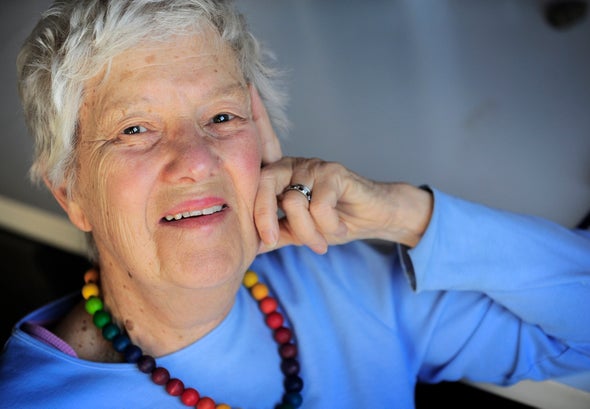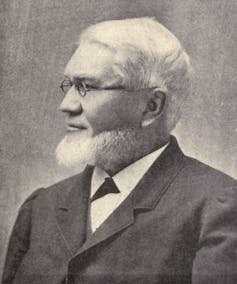The groundbreaking scientist ushered in a revolution in how we think about the universe. She also lived by a set of principles that made her an exceptional human being
By Ashley Jean Yeager on August 17, 2021
 Rubin at her office at the Carnegie Institution of Washington in 2010, at the age of 82. Credit: Linda Davidson Getty Images
Rubin at her office at the Carnegie Institution of Washington in 2010, at the age of 82. Credit: Linda Davidson Getty Images“Could I come to the telescope with you?” I innocently asked the late astronomer Vera Rubin that question a few weeks after I met her in 2007.
Even then, in her late 70s, Rubin continued her trips to places such as Kitt Peak National Observatory to scour the outermost edges of far-flung galaxies in order to clock how quickly the galaxies’ stars whipped around their cores. In our solar system, Mercury whips around the sun at high velocity, while Pluto merely plods along, and astronomers naturally assumed that stars close to a galaxy’s core would similarly move faster than stars out at the edge.
Yet years of work with her collaborator Kent Ford and other colleagues had revealed that this isn’t true; the stars farthest out tend to move just as swiftly as stars closer in. In the 1960s and 1970s, this observation shocked scientists. It implied that the gravity from some invisible form of matter was making the outermost stars move unexpectedly quickly—and that there was vastly more matter in the cosmos that astronomers originally thought. It meant, as Rubin so adeptly noted in 1985, the universe had been playing a trick on us, keeping the majority of the universe’s matter hidden from view.
I had not known about the universe’s trick until I came across a description of Rubin’s research while interning at the National Air and Space Museum in Washington, D.C., and wandering around the Explore the Universe exhibit. Reading about Rubin, my brain buzzed. Who was she? Why hadn’t I heard more about her? Did we really not know what most of the universe was made of? I peppered my supervisor, David DeVorkin, with these questions and others. He pointed me to Rubin’s collection of essays, Bright Galaxies, Dark Matters. A day later he asked: “Would like you to interview Vera?”
Absolutely, yes, I said. DeVorkin was working on Rubin’s oral history, which he wanted to finish. I read and researched, preparing questions. On the day of the interview, Rubin welcomed us into her office at the Department of Terrestrial Magnetism, the same one she’d shared with Ford for decades. Dozens of stories and anecdotes later, we headed to Rubin’s home not far from Chevy Chase, where both Vera and Robert Rubin, her husband, answered our questions. The couple finished each other’s thoughts. They made each other laugh. In that afternoon, their love and respect for each other were obvious, even unspoken. That’s the kind of relationship I want, I remember thinking.
Finding a partner who was patient, kind and as invested in your career as in their own, was advice Rubin often gave in talks and interviews. She not only said it. She lived it. She also showed me how to make others feel important. Even though I was a stranger, an intern, she listened to me. She asked me questions about my aspirations. She encouraged me. She didn’t have to do that. She chose to.
Because I felt Rubin was so approachable, I dared to write and ask to go to the telescope with her. She thanked me for my “sweet letter,” and in a September 20, 2007 e-mail wrote, “The answer is yes, but … telescope time is very valuable and making mistakes is very easy.” She told me when to arrive at the telescope, when to watch her work and when to ask questions. And then she said, “Bring a warm coat or jacket … we’ll be observing in a warm room but have to go out to the telescope sometimes.” She was open to my request, set boundaries and still looked out for my well-being. High expectations and warmth (no coat pun intended) again were traits I wanted to emulate.
On that crisp night in mid-November 2007, we met at Kitt Peak. That first night there, she flicked a switch, and the darkness of the telescope’s dome swallowed her. She quickly and confidently took a few steps, grabbed the staircase railing, and climbed up. At the top, she slid her hand across the door, found the knob and pushed. Nothing happened. Like a football lineman, she lowered her center of gravity and threw her weight against the hinged hunk of metal, bumping it open with her hip. That scene became the opening of my book, Bright Galaxies, Dark Matter and Beyond, a tour of Rubin’s life. In it, I try to convey her grace, wit and grit, even in the face of sexism and sometimes scorn for her research. I also explore the life lessons she taught me: Listen, speak up against injustice, be fearless and, above all, be curious.
ADVERTISEMENT
“Don’t shoot for the stars, we already know what’s there,” she once said. “Shoot for the space in between because that’s where the real mystery lies.”
This essay was adapted from the author's new book Bright Galaxies, Dark Matter and Beyond.
This is an opinion and analysis article; the views expressed by the author or authors are not necessarily those of Scientific American.
ABOUT THE AUTHOR(S)
Ashley Jean Yeager is the associate news editor at Science News. She holds a bachelor's degree in journalism from the University of Tennessee, Knoxville, and a master's degree in science writing from MIT. She is the author of Bright Galaxies, Dark Matter and Beyond, a biography of astronomer Vera Rubin. Follow her on Twitter @AshleyJYeager.
Astronomers were skeptical about dark matter — until Vera Rubin came along
She built a bulletproof case for exploring the concept.
By Byrd Pinkerton and Noam Hassenfeld
/cdn.vox-cdn.com/uploads/chorus_image/image/69735595/630671744.0.jpg)
Vera Rubin didn’t “discover” dark matter, but she put it on the map.
Dark matter is a wild concept. It’s the idea that some mind-boggling percentage of all the matter in the universe may be invisible, and wholly unlike the matter that makes up Earth. Rubin is celebrated because she forced much of the astronomy community to take it seriously.
That reckoning moment came in 1985, when she stood in front of the International Astronomical Union and walked the audience through some of the data she had collected.
Her data showed that stars at the edges of multiple galaxies were moving in ways that didn’t make sense, according to the rules of physics. One possible explanation for this strange phenomenon, Rubin suggested, was the existence of a mysterious “dark matter” at the edges of the galaxy. In the decades since that talk, research into dark matter has exploded, revolutionizing astronomy.
In Bright Galaxies, Dark Matter, and Beyond, a new biography of Rubin, science journalist Ashley Yeager explains how Rubin, who died in 2016, grew from a young researcher whose bold ideas were initially ignored into the kind of scientist who could change an entire field. In 2020, we interviewed Yeager for an episode of the Unexplainable podcast about dark matter. A transcript of our conversation, lightly edited for length and clarity, follows.
Noam Hassenfeld
When did Vera Rubin first get interested in astronomy? What’s her origin story?
Ashley Yeager
About the age of 11 is when she started to look at the stars. Vera and her sister, Ruth, shared a bedroom in their Washington, DC, townhouse. And Ruth remembers Vera constantly crawling over her at night to be able to open the windows and look out at the night sky and start to track the stars. So clearly, Vera was captivated by the night sky. And that stuck with her.
She then went to Vassar, where she studied astronomy. [While at Vassar, she met a mathematician named Robert Rubin.] They ended up getting married. And that drove one of the biggest decisions in Vera’s life, because she wanted to go to graduate school for astronomy.
She’d gotten into Harvard, but Robert Rubin was at Cornell. He was well into his graduate studies. They had to make a choice, and Vera said, “Let’s stay together. I’ll come to Cornell with you and I’ll do my master’s in astronomy while you finish your PhD in physics.”
Noam Hassenfeld
Isn’t that kind of a wild choice? To choose Cornell based on a husband?
Ashley Yeager
It’s the late 1940s. And Vera, in some ways, was very traditional, even though she was nontraditional in other ways. She felt that she was expected to get married by the end of her four years at Vassar. That was still something that was societally kind of expected.
And I actually think it set her up to be more successful than maybe she would have been, had she gone to Harvard or Princeton or somewhere else, just because of the exposure that she got. There was intellectual freedom she had at Cornell, to be able to probe into different questions in astronomy that she probably would have been pushed away from, had she been in a more structured graduate program.
Noam Hassenfeld
So she’s at Cornell. She’s probing into questions. She’s got a lot of intellectual freedom. What are the big questions that are occupying her mind?
Ashley Yeager
The biggest one, which becomes her master’s thesis, is really the idea of “Does the universe rotate?”
Noam Hassenfeld
Wait, does the universe rotate?
Ashley Yeager
So, probably no. This was a question posed by a very eccentric astronomer named George Gamow. Vera’s husband actually showed Vera this paper that George Gamow had written about this idea. And she thought, “Well, why would we not try to answer that question?”
Noam Hassenfeld
The kind of question that, if she were at another university, maybe she wouldn’t have had the freedom to dive into?
Ashley Yeager
I think so. I get the sense, reading through the literature and looking through the history, that she probably would have been guided to a more traditional question.
And as she started to look through the data, the numbers started to suggest that there was this odd, sideways motion that perhaps could be interpreted as a universal rotation. She presented her idea to her master’s thesis adviser, William Shaw.
He says, “Your conclusion is really good. I want to present it under my name at this upcoming astronomy conference.”
And Vera is like, “No! I might not be a member of this society yet. But you’re not presenting my data for me. I’m going to present it under my own name, come hell or high water.”
Noam Hassenfeld
So does she?
Ashley Yeager
Yes. She goes to this meeting. Apparently, the drive from New York to Pennsylvania, where the meeting was, was harrowing. It was the winter, snowy. They had a newborn in the car. Her dad was actually driving because he was the only one with a car at the time.
But she gives the presentation, and the reaction is less than great. There are some heavy critics in the room. A lot of scoffing. She does have one person, Martin Schwarzschild, who encourages her. He says, “This is really interesting. But we need more data to be able to make this conclusion.”
And that’s a criticism that really sticks with her throughout her career. Later on, she really tries to have or collect as much data as possible to support her conclusions, just because of that experience.
Noam Hassenfeld
What happens next?
Ashley Yeager
She takes a little bit of a break, because she really has this strong sense of wanting to set up a home and start a family. There’s this moment in the early 1950s, when she’s at the playground with her son. She had been reading astrophysical journals to stay connected with what was going on in astronomy.
So her son’s playing in the sandbox and she’s reading the journal, and she just breaks into tears because she misses doing research so much. She misses that curiosity of asking questions and searching for data, and really trying to figure out the answers to how the universe works.
It’s at that point that her husband says, “You need to go back to school. It’s time. We’ll figure out child care. We’ll figure out how to get dinners made. But let’s do it.”
Noam Hassenfeld
So she goes back into astronomy. And eventually she starts doing research at Kitt Peak National Observatory, right? What’s that like?
Ashley Yeager
We’re talking late 1960s. This is a 84-inch telescope, very large. Vera is at the telescope with Kent Ford, her collaborator. They’re looking at this galaxy called Andromeda, which is our nearest neighbor. They’re looking at these really young, hot stars on the edge of the galaxy, and they’re trying to get the speeds of these stars — how fast are these stars going around Andromeda?
So they’re looking at the data, and they’re going, “Oh my gosh, this is not what we expected.” The assumption was that the stars closer in would fly around the sun fast, and the stars farther out would go super slow. But these stars were moving faster than they expected.
The only way for those stars far out in the galaxy to move that fast is [that] there’s got to be something happening out there that we don’t understand.
Noam Hassenfeld
What does she think is going on?
Ashley Yeager
Well, she’s not really sure. And again, she doesn’t like to make assumptions or speak without data. So she and Kent Ford, and a couple other people, they really start to do a systematic study of galaxies.
She does 20 galaxies, and then 40, and then 60. And they all show this bizarre behavior of stars, these stars out far in the galaxy, moving way, way too fast. So at that point, you know, the astronomy community is like, “Okay, we have to deal with this.”
In 1985, Vera Rubin gives this talk at the IAU. She says, “Nature has played a trick on us. That we have been studying matter that makes up only a small fraction of the universe. The rest of the universe is stuff that we don’t understand, and we can’t see it.”
And I think because she did this in so many galaxies — we’re talking 60 galaxies — there was really no denying it. It was really her work that pushed the community over the edge, to say we have to accept the idea that dark matter exists.
Noam Hassenfeld
It sounds like if you really want to upend our entire conception of the universe, you have to come with some data.
Ashley Yeager
Yeah, absolutely. Because she held onto that criticism of her master’s and PhD work — she would just go after the data, and really make sure that the story she told from that data rang true.
One of the things that made her a remarkable scientist is her perseverance. She did face a lot of roadblocks, especially because she was a woman in science in the 1940s, 1950s, 1960s. She had to really persevere. Unfortunately, she will never get to see or know what dark matter is. But I don’t know that she had a problem with that. She would take pride in the fact that she opened a whole new realm of astronomy and physics.
She basically created more questions than answers, and I think that’s the mark of a remarkable scientist: when you open up these questions that no one ever thought of before. When you create a whole new generation of scientists who can go and answer them.







 Aug 16, 2021
Aug 16, 2021




